NSDC/Natural Satellites Data Center
GUIDE FOR THE PHENOMENA
OF THE NATURAL PLANETARY SATELLITES
Some natural satellites of the planets present phenomena such as occultation
or eclipse which may be observed in order to determine their positions
together with photometric parameters. We will see below the different types
of phenomena occurring for each family of satellites.
Phenomena were observed with an astrometric purpose a long time before
the observation of direct astrometric positions. When the instruments did
not make precise measurements, the observation of a phenomenon provided
an astrometric information: for example, when a satellite passes in front
of another satellite (occurrence of an occultation), it is possible to
say that the satellites have the same positions within an error not larger
than the size of the satellite! In fact the interpretation of the observation
is slightly more complex but the observation of phenomena was performed
as soon as the satellites of Jupiter were discovered by Galileo and are
still observed.
1) Description of the phenomena satellites-planet:
When the Sun passes through the orbital plane of a satellite, the shadow
of the planet may eclipse the satellite and the umbra of the satellite
may pass on the disk of the planet. These events called eclipse of the
satellite and transit of the umbra are observable independantly
of the observer.
When the Earth passes through the orbital plane of the satellites, a
terrestrial observer may see the satellite being occulted by the planet
or the satellite transiting on the disk of the planet. These events are
called occultation of the satellite and transit of the satellite
and depend on the observer.
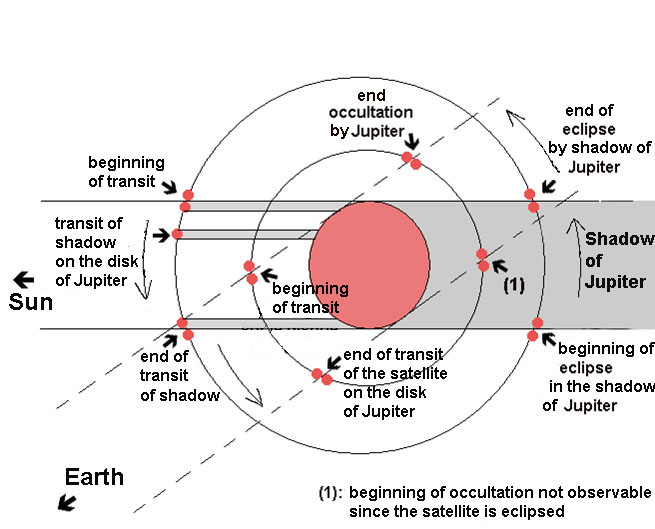 These events are well known for the Galilean satellites of Jupiter and
observed since their discovery. Only the eclipses and the occultations
have been used for astrometric purpose. The occultations being difficult
to observe, the eclipses are the most numerous observations of the galilean
satellites since their discovery.
These events are well known for the Galilean satellites of Jupiter and
observed since their discovery. Only the eclipses and the occultations
have been used for astrometric purpose. The occultations being difficult
to observe, the eclipses are the most numerous observations of the galilean
satellites since their discovery.
These events occur also for other planets for the satellites sufficiently
close to their primary in order to be catch by the shadow cone. If they
are far from the planet, the penumbral cone catching a satellite is not
observable.
For the planet Jupiter, these events are observable each year. Only
Callisto does not present events when the Earth and the Sun are to high
above its orbital plane.
For the planet Saturn, these events occur for satellites S-1 to S-7
only one year before and one year after the transit of the Sun and the
Earth in the common orbital plane of the satellites. This transit occur
every 15 years, in 1980, 1995, 2010, ...
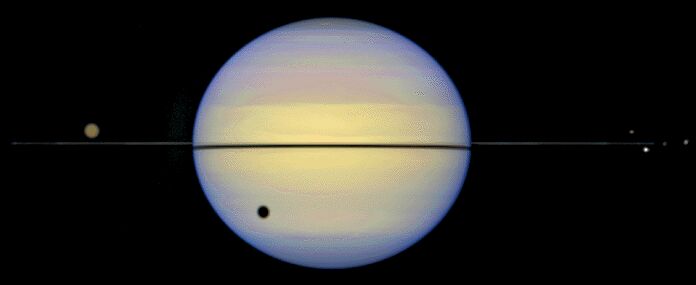 Transit of the shadow of Titan on the disk of Saturn on April 24,
1996 (c)HST
For the planet Uranus, these events occur during several months every 42
years, in 1965, 2007, ...
Transit of the shadow of Titan on the disk of Saturn on April 24,
1996 (c)HST
For the planet Uranus, these events occur during several months every 42
years, in 1965, 2007, ...
For the planet Neptune, eclipses of Triton occur during several months
every 82 years, in 1964, 2046, ...
For Pluto, eclipses and occultations of Charon occur during several
months every 124 years, in 1980, ...
The predictions of these phenomena are available here.
2) Observation of the eclipses and occultations by the planet
An observation of an eclipse is a photometric observation providing a light
curve (magnitude of the satellite depending on time) or an evaluation of
the instant of disappearance or reappearance of the satellite (deduced
from the light curve or from a visual observation).
The time of the event published in the files of data are commonly the
time of the mid-extinction or mid-reappartion of the satellite (half flux
of the satellite visible unless another specification in the comments).
An observation of an occultation is the evaluation of the time of the
contact between the disk of the satellite and the disk of the planet. These
observations have been made only visually.
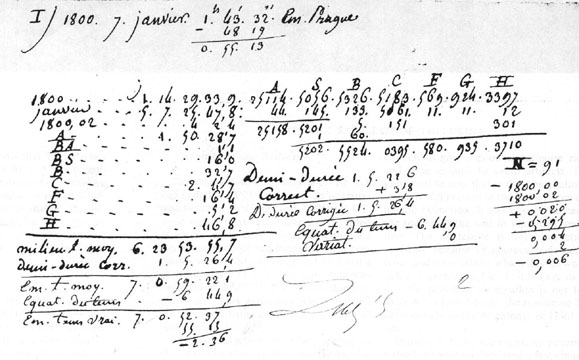 Observation of an eclipse of Io made by Delambre in 1800:
time and half duration are recorded
Observation of an eclipse of Io made by Delambre in 1800:
time and half duration are recorded
|
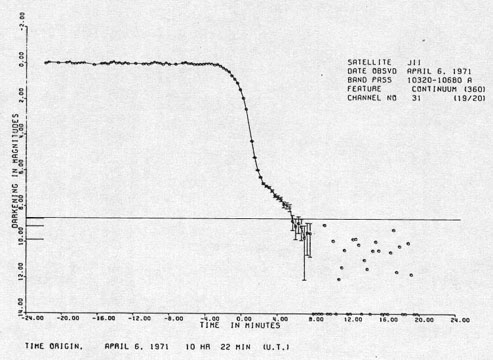 Observation of an eclipse of Europa made with a photoelectric photometer
in 1971: the light curve is recorded
Observation of an eclipse of Europa made with a photoelectric photometer
in 1971: the light curve is recorded
|
3) Description of the mutual events satellites-satellites
In fact, such phenomena satellites-planet are also possible in the configuration
satellite-satellite. One should understand that these events are much more
rare than the events implying the planet since the satellites project a
smaller shadow cone. However, such events occur between the satellites
orbiting in the same plane (J-1 to J-4, S-1 to S-7, U-1 to U-5) during
several months at the same dates than for the events implying the planet.
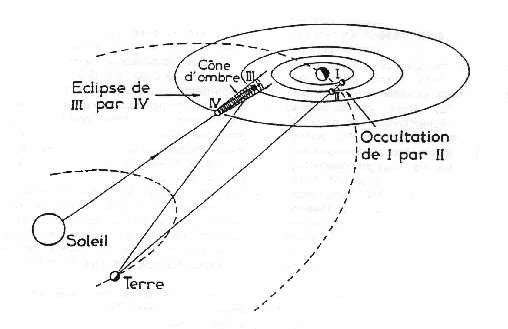 Configurations of the Galilean satellites during the mutual events
The mutual events are of several types: occultation or eclipse, total,
partial or annular as shown below. The light curve may differ for these
different events.
Configurations of the Galilean satellites during the mutual events
The mutual events are of several types: occultation or eclipse, total,
partial or annular as shown below. The light curve may differ for these
different events.
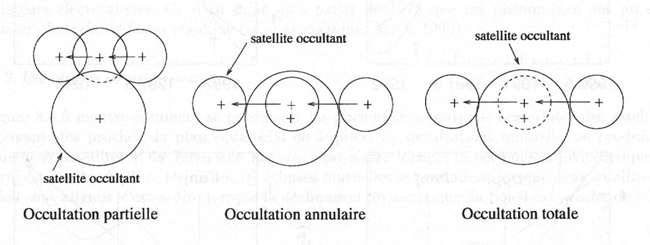
 The predictions of these phenomena are available here.
The predictions of these phenomena are available here.
4) Observation of the mutual events
An observation of a mutual event is a photometric observation of the variation
of the light flux of the satellites. This observation is much more accurate
than the observation of an eclipse by the planet because most of the satellites
have no atmosphere disturbing the light curve because of the refraction
of the light. The observational data consist in the entire light curve
which may be re-reduced for any photometric or astrometric purpose. The
data deduced are the time of the minimum of the light curve together with
the magnitude drop usable for astrometric purpose. This type of observation
is one of the most precise, especially when taking into account the distribution
of albedo and the influence of the phase angle on the apparent brightness
of the satellites.
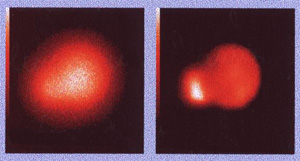 Occulation of J3 by J2 in 1997
Adaptive optics (c)CNRS/ESO
Occulation of J3 by J2 in 1997
Adaptive optics (c)CNRS/ESO
|
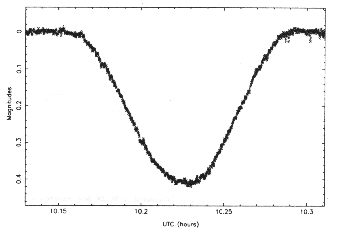 Shape of the light curve observed during a mutual event
J3 occults J2 on June 10, 1985 (c)CNRS/ESO
Shape of the light curve observed during a mutual event
J3 occults J2 on June 10, 1985 (c)CNRS/ESO
|
5) Time-scale
The time scale associated to the observations is essential for the use
of the data. The time scale is the link between observations absolutely
necessary for dynamical analysis. One will remind that dynamical studies
need to use the TT (terrestrial time) which is the extension of the former
ET (ephemeris time), supposed to be uniform, that UT is not. Unfortunately,
the astrometric observations are never provided in TT so that one will
be aware of two items:
- the relationship between the time scale used by the observer and
TT
- the accuracy of the measurement of the timings of the observations
by the observer to the time scale used.
The first one should be documented by the observer. Most of the observers,
at the present time, use UTC (universal time coordinated) provided through
GPS, phone and broadcasted worldwide. However, for some raw data, local
time may have been used. In that case, most of time, the difference to
UTC is a round number of hours and the correction is easy to make. For
old observations, the time scale provided may be a local mean time or true
solar time. Then, it is necessary to know exactly the longitude of the
observational site to go back to the universal time. The relationship between
UT and TT is provided by IERS.
The second item concerns the accuracy of the timing. Unfortunately,
most of the observers do not provide this information. note that an error
of one second of time corresponds, for a satellite moving at 10km/s, to
10km... From years, the accuracy of the timing to 0.1 second of time is
easy to obtain and is sufficient for most of the utilizations of the data.
During the observation of an event, each photometric recorded measure must
be referred to UTC within an accuracy at least of 0.1 second of time.
6) Influence of the receptor
You will find in the comment files, when available, the receptor used.
Observations of phenomena are photometric observations and have been made:
- visually using a comparison method to photometric standard. This
type of observation is of poor accuracy but may be useful in some cases..
- using a photoelectric photometer. The photometric accuracy may be
of a high level but requires to be careful before and after the observations
when recording some photometric standard.
- using a CCD. In that case, images containing several objects may
be recorded and the sky background as well as reference objects are available
for the reduction of each image. A good relative photometry is possible.
back to
NSDC home page









